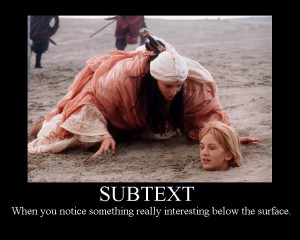SUBTEXT
You’ll hear this crap debated a lot: ‘It’s not about the gear it’s about the story’. To be honest, I switch off as soon as I see one of those debates rear its ugly head. It always seems to descend into tubthumping amongst those whose time appears to be better spent talking than doing. Twitter is murder for that. It’s one of the reasons I’ve ceased posting on my own blog, it was just taking up way too much time, time better spent actually developing my career and getting better at what I enjoy most: fiction.
I’ve never met a single filmmaker, not a single one, who didn’t harbour a small desire to bust out a short film, just some little work of narrative, to satisfy the innermost vanity. The apogee of our work is the feature film (wrongly in my opinion, US TV drama has elevated the form to a level I never thought possible) and it’s perfectly natural for us all to paint our little piece of perfection into the cannon of contemporary cinema. Except that it probably won’t be perfect, in fact far from it. Drama’s a hard bastard, and it takes time not only to develop your technical skills, your appreciation of film grammar but also your emotional sensibilities. Add into all this the vulnerability needed to present your work with absolute honesty (the hallmark of the great filmmakers) and that’s a lifetime’s work. Today’s cameras make it easier to deliver work that’s easy on the eye, and ‘looks’ right, for the kinds of budgets we all suffer with. We all know this. What shallow DOF won’t give you is good lighting, good writing or good acting.
So, why’s this post called subtext? Well, it’s to introduce an idea that I hope will nestle in the back of your mind and inform the way you think about your work from here on in. Subtext is the language beneath the language we use. It’s the implied meaning, and it’s discovery requires an active impulse from the discoverer. It’s also the defining characteristic of film. Cinema is a show-not-tell medium. The great joy of cinematic drama is in the viewer’s discovery of meaning for themselves, coming to an understanding all by yourself and the skill of the filmmaker resides in their ability to facilitate that process.
I’ve lost you haven’t I?
Let’s say I shoot a simple two shot of a couple arguing, then cut to a shot of a burnt meal. You’d get it, would you not? That’s a very simple example but there’s absolutely no need for either of the characters to mention the food, in fact it would be more powerful if they didn’t. Subtext exists below language, in the implied meaning of what we say and it’s incredibly important for film because it creates drama. For subtext read subterfuge. We all do it, manipulating language so that our meaning is clear yet the words we speak mean something completely different.
Example: I fall over, you ask, are you okay? I say yes, I’m fine.
Am I actually hurt? Yes, but I’m making light of it. Why? Possibly because I don’t want to show weakness, possibly because I’m too proud, possibly because I don’t want you to worry. You see? The implied meaning in that simple phrase is deep and layered and an audience will get it but you have to be brave enough to let them come to it all by themselves. By directing your actors and by directing the camera. It’s not enough simply to render a scene, you have to really understand what’s going on. Good writing is underpinned by a vast and intricate scaffolding of subtext.
So, bear that in mind when thinking about shooting drama. And also bear in mind that this is really really really hard. You can go mad unravelling the subtext and trying to piece it all together as a cohesive scene. As always, practice makes perfect. Most filmmakers will never advance beyond the mediocre because they just don’t get this. As always, with us WOC lot, we challenge ourselves to be better and hope to bring you along too.
-
http://twitter.com/rescuethecows Loren
-
Chazan







